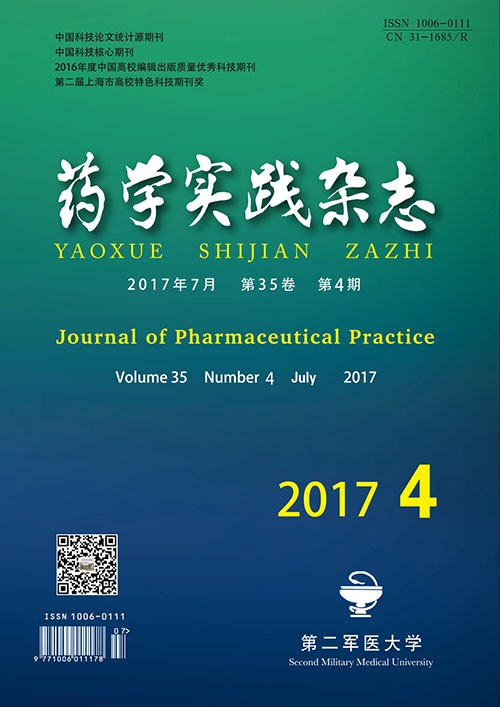WANG Xiaojing, WANG Dongxing, FAN Jie, GAO Yue, ZHANG Hai. Inhibitory effect of Euphorbia helioscopia on human triple-negative breast cancer MDA-MB-231 cells and its possible mechanism of apoptosis[J]. Journal of Pharmaceutical Practice and Service, 2017, 35(4): 337-340,358. doi: 10.3969/j.issn.1006-0111.2017.04.012
| Citation:
|
WANG Xiaojing, WANG Dongxing, FAN Jie, GAO Yue, ZHANG Hai. Inhibitory effect of Euphorbia helioscopia on human triple-negative breast cancer MDA-MB-231 cells and its possible mechanism of apoptosis[J]. Journal of Pharmaceutical Practice and Service, 2017, 35(4): 337-340,358. doi: 10.3969/j.issn.1006-0111.2017.04.012
|
Inhibitory effect of Euphorbia helioscopia on human triple-negative breast cancer MDA-MB-231 cells and its possible mechanism of apoptosis
- 1.
International Cooperation Department, Chinese Pharmaceutical Association, Beijing 100022, China
- 2.
263 Clinical Division, Army General Hospital, Beijing 100022, China
- 3.
Shanghai First Maternal and Infant Hospital affiliated to Tongji University, Shanghai 201204, China
- 4.
Center of Experimental Teaching, School of Pharmacy, Second Military Medical University, Shanghai 200433, China
- Received Date: 2017-05-27
- Rev Recd Date:
2017-07-03
-
Abstract
Objective To investigate the effect of Euphorbia helioscopia on MDA-MB-231 cells and its mechanism. Methods The cell viability was detected by MTT assay. The production of ROS in MDA-MB-231 cells was measured by fluorescence microscopy. The apoptotic rate was detected by flow cytometry. Apoptosis DNA fragments were detected by TUNEL assay. Western blot was used to assess the expression of caspase-9, caspase-3 and PARP. Results MTT assay showed that the extract significantly inhibited the viability of MDA-MB-231 cells, which can be diminished by the ROS inhibitor NAC and the caspase inhibitor Z-VAD-FMK. The marked increase in the production of ROS induced by the extract was observed with fluorescence microscopy. Flow cytometry showed that the PI positive staining cells increased significantly after the treatment of the extract, but was diminished by NAC. Caspase-9 and caspase-3 were activated after the treatment of the extract while the PARP was cleaved. TUNEL showed that a significant increase in apoptotic DNA fragmentation induced by the extract, which can be diminished by NAC and Z-VAD-FMK. Conclusion Ethyl acetate extract inhibited the MDA-MB-231 cells and induced apoptosis. The mechanism may involve with the mitochondrial damage due to the excessive ROS.
-
References
|
[1]
|
Campbell RA, Bhat-nakshatri P, Patel NM, et al. Phosphatidylinositol 3-kinase/AKT-mediated activation of estrogen receptor alpha: a new model for anti-estrogen resistance[J]. J Biol Chem, 2001, 276(13): 9817-9824. |
|
[2]
|
Hseu YC, Lee CC, Chen YC, et al. Antrodia salmonea in submerged culture exhibits antioxidant activities in vitro and protects human erythrocytes and low-density lipoproteins from oxidative modification[J]. Food Chem Toxicol, 2014, 66(4): 150-157. |
|
[3]
|
Shah SP, Roth A, Goya R, et al. The clonal and mutational evolution spectrum of primary triple-negative breast cancers[J]. Nature, 2012, 486(7403): 395-399. |
|
[4]
|
Cleator S, Heller W, Coombes RC. Triple-negative breast cancer: therapeutic options[J]. Lancet Oncol, 2007, 8(3): 235-244. |
|
[5]
|
Wang K, Zhang C, Bao J, et al. Synergistic chemopreventive effects of curcumin and berberine on human breast cancer cells through induction of apoptosis and autophagic cell death[J]. Sci rep, 2016, 6: 26064. |
|
[6]
|
Jeong HS, Choi HY, Lee ER, et al. Involvement of caspase-9 in autophagy-mediated cell survival pathway[J]. Biochim Biophys Acta, 2011, 1813(1): 80-90. |
|
[7]
|
Green DR. Apoptotic pathways: paper wraps stone blunts scissors[J]. Cell, 2000, 102(1): 1-4. |
|
[8]
|
杨 莉, 陈海霞, 高文远. 泽漆化学成分及药理作用研究进展[J]. 中草药, 2007, 38(10): 1585-1589. |
|
[9]
|
D'Anneo A, Carlisi D, Lauricella M, et al. Parthenolide generates reactive oxygen species and autophagy in MDA-MB231 cells. A soluble parthenolide analogue inhibits tumour growth and metastasis in a xenograft model of breast cancer[J]. Cell Death Dis, 2013, 4(10): e891. |
|
[10]
|
Elumalai P, Gunadharini DN, Senthilkumar K, et al. Induction of apoptosis in human breast cancer cells by nimbolide through extrinsic and intrinsic pathway[J]. Toxicol Lett, 2012, 215(2): 131-142. |
|
[11]
|
Hseu YC, Lee CC, Chen YC, et al. The anti-tumor activity of Antrodia salmonea in human promyelocytic leukemia (HL-60) cells is mediated via the induction of G(1) cell-cycle arrest and apoptosis in vitro or in vivo[J]. J Ethnopharmacol, 2014, 153(2): 499-510. |
|
[12]
|
Mcilwain DR, Berger T, Mak TW. Caspase functions in cell death and disease[J]. Cold Spring HarbPerspect Biol, 2013, 5(4): a008656. |
-
-
Proportional views

-







 DownLoad:
DownLoad: